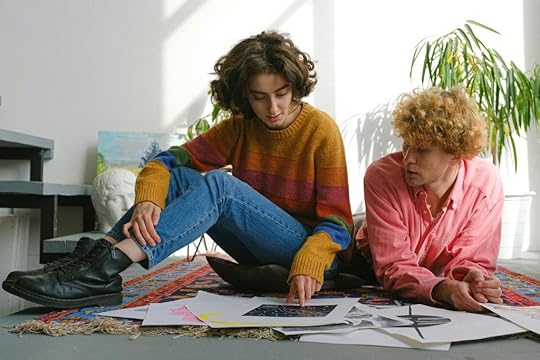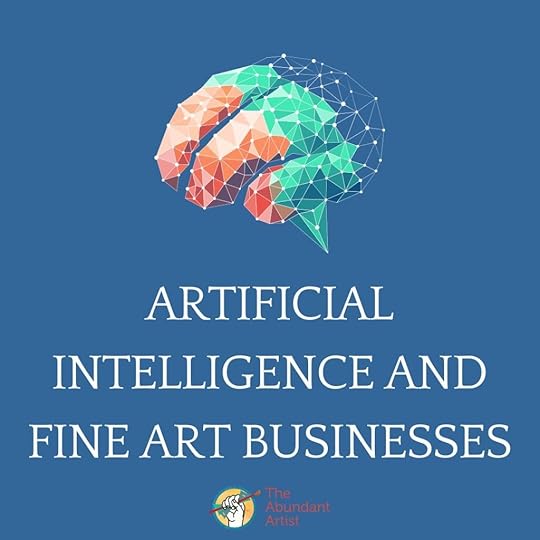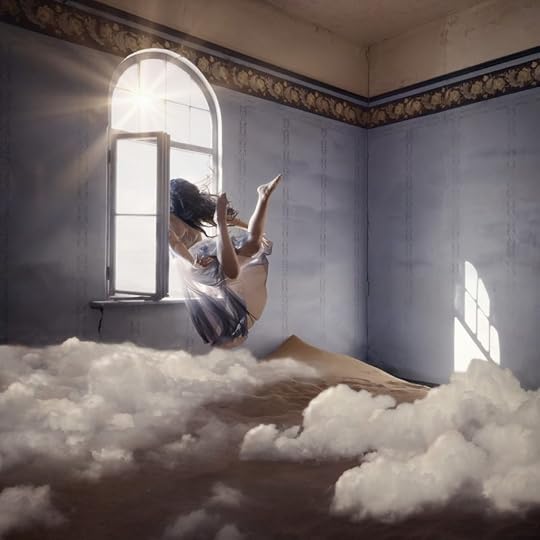Cory Huff's Blog: The Abundant Artist Goodreads blog
October 22, 2024
The Importance of Branding for Artists Online
If you are an artist, you should already know how difficult it is to enter the sales world. From painters and visual artists to photographers and illustrators, as well as gallerists and curators, the need for a distinct brand has never been more critical.
Branding is not just about a logo or a catchy tagline; it’s the essence of how artists present themselves to the world. In this article, we will explore the importance of branding for artists and how it can significantly influence their success across both physical and digital spaces.
Understanding BrandingAt its core, branding is the process of creating a unique identity for a product or individual. For artists, this involves defining who they are, what they stand for, and how they want to be perceived by their audience. Effective branding goes beyond visual elements; it encompasses the artist’s style, message, values, and the emotional connection they create with their audience.
 Why Branding MattersDifferentiation in a Crowded Market
Why Branding MattersDifferentiation in a Crowded MarketThe internet is teeming with talented artists, making it crucial to stand out. A strong brand helps artists differentiate themselves from their peers. This differentiation can come from various factors, such as unique artistic style, storytelling ability, or the themes they explore in their work. By establishing a clear brand identity, artists can carve out a niche for themselves, making it easier for people interested in their art to discover and remember them. If you’re looking for ways to build a unique artist brand, these strategies can help you stand out.
Building Trust and CredibilityBranding fosters trust. When artists consistently present themselves in a professional manner, they build credibility with their audience. For more on enhancing your professional image, check out how to create a Facebook page for your art. This is especially important in an age where audiences are bombarded with content and seek authenticity in the artists they support. A well-defined brand can reassure potential art buyers that they are engaging with a serious artist rather than just another fleeting online presence.
Creating Emotional ConnectionsBranding is about storytelling. It allows artists to share their creative journey, artistic values, and the inspiration behind their work. When artists share their stories, they create emotional connections with their audience. Learn how to use storytelling to sell your art and deepen these connections. People interested in your artworks are more likely to support artists whose stories resonate with them. This emotional bond can lead to increased loyalty, engagement, and ultimately, sales.
Enhancing Marketing EffortsA strong brand makes marketing more effective. Artists can leverage their branding across various platforms, ensuring a consistent message that resonates with their target audience. Whether it’s through social media, email newsletters, or a personal website, a cohesive brand presence can streamline marketing efforts and improve overall visibility. Consider these tips on email marketing for artists to further enhance your outreach. When your audience recognizes an artist’s brand, they are more likely to engage with their content and share it with others.
 Key Elements of Effective Branding for ArtistsVisual Identity
Key Elements of Effective Branding for ArtistsVisual IdentityThe visual aspects of branding, including logos, color schemes, and typography, play a vital role in establishing an artist’s presence. These elements should reflect the artist’s personality and artistic style. For example, a painter specializing in vibrant landscapes might choose a palette of bright colors and flowing, natural shapes that reflect the essence of their work. Consistency in visual identity across all platforms strengthens brand recognition.
Artistic Voice and StyleAn artist’s voice is an integral part of their brand. This encompasses the themes, messages, and emotions that resonate in their work. Explore more on developing a unique artistic style and how it can define your brand. Artists should strive to develop a unique style that sets them apart from others. This may involve experimenting with different mediums, techniques, or narratives. A distinct artistic voice helps in attracting the right audience and establishing a loyal following of people interested in their work.
Online Presence and EngagementIn the digital age, an artist’s presence across digital platforms is crucial. This includes having a professional website, active social media accounts, and a portfolio that showcases their work. Engaging with fans and followers is also vital. Artists should respond to comments, share behind-the-scenes content, and create a dialogue with their audience. This interaction not only humanizes the artist but also fosters a sense of community.
StorytellingEffective branding involves compelling storytelling. Artists should share their journey, inspirations, and the process behind their work. This not only makes the artist relatable but also enriches the audience’s experience. Stories can be shared through blog posts, social media updates, or video content. By weaving narratives into their branding, artists can captivate their audience and encourage them to invest in their journey.
Consistency Across PlatformsConsistency is key in branding. Artists should ensure that their branding is cohesive across all platforms, from social media and their personal website to physical promotional materials used in galleries and art shows. This consistency helps reinforce their identity and makes it easier for their audience to recognize them. Additionally, a cohesive brand presence builds trust and professionalism, further solidifying the artist’s reputation in the online space.
 The Impact of Branding on Sales and Opportunities
The Impact of Branding on Sales and OpportunitiesA well-established brand can significantly impact an artist’s ability to sell their work and attract opportunities. When people interested in your artworks feel a connection to an artist’s brand, they are more likely to purchase artwork, prints, or commissioned pieces. Additionally, a strong brand can lead to collaboration opportunities, sponsorships, and even gallery shows. For personalized support in growing your art business, explore our business coaching for artists services. Artists who effectively leverage their branding can expand their reach and create multiple income streams.
Branding is an essential aspect of success for online artists. It serves as the foundation for differentiation, trust-building, emotional connection, and effective marketing. By understanding and investing in their brand, artists can create a unique identity that resonates with their audience and propels their careers forward in both physical and digital realms. As the digital landscape continues to evolve, those who prioritize branding will be better positioned to navigate challenges, seize opportunities, and leave a lasting impact on the art world.
The post The Importance of Branding for Artists Online appeared first on How to Sell Art Online | Online Marketing for Artists.
October 17, 2024
Legal Aspects of Selling Art Online: Copyrights, Contracts, and More
Selling art online has become an increasingly popular avenue for artists to showcase and monetize their work. However, this convenience comes with a set of legal considerations that every artist and seller should be aware of.
Among these, copyrights stand out as a fundamental aspect of selling art online. This article will delve into the legal landscape surrounding online art sales, focusing on copyrights, contracts, and additional legal concerns that artists need to navigate.
 Understanding Copyrights
Understanding CopyrightsCopyright is a form of intellectual property protection that grants the creator exclusive rights to their work. In the context of art, copyright protects the expression of ideas rather than the ideas themselves. This means that an artist holds the exclusive right to reproduce, distribute, and display their artwork. When selling art online, understanding copyright is crucial for both artists and buyers.
Key points to remember:
Automatic protection: Copyrights are generally granted automatically upon creation of a work.Registration: While registration is not mandatory, it provides additional benefits, such as the ability to sue for infringement and recover statutory damages.Copyright infringement: If someone infringes on your copyright, you may have legal recourse. How Copyright Works
How Copyright WorksIn most jurisdictions, copyright is automatically conferred upon the creation of an original work. This means that as soon as an artist creates a piece of art, they own the copyright to it, provided it is fixed in a tangible medium. This includes paintings, drawings, digital art, and photographs. While registration of copyright with a government authority can enhance an artist’s ability to enforce their rights, it is not a requirement for protection.
Copyright InfringementSelling art online also means that artists must be vigilant about copyright infringement. Unauthorized use of an artist’s work—such as reproducing it without permission—constitutes infringement. This can occur in various forms, including digital reproductions, merchandise, or even unauthorized displays on social media platforms. Artists need to be proactive in monitoring the use of their work and be prepared to take legal action if necessary.
Contracts: The Backbone of Online SalesIn addition to understanding copyright, artists should be well-versed in the importance of contracts when selling art online. Contracts serve as legal agreements between parties and are essential for clarifying the terms of sale, rights granted, and obligations of each party.
Essential Elements of a Sales ContractA solid sales contract should include the following elements:
Description of the Artwork: Clearly describe the artwork being sold, including dimensions, medium, and any unique features.Purchase Price: Specify the price agreed upon for the sale and any applicable taxes or fees.Payment Terms: Outline how and when payment will be made, including any deposit requirements.Delivery Terms: Define how the artwork will be delivered, who is responsible for shipping costs, and the timeline for delivery.Copyright and Licensing: Clearly state whether the seller retains copyright or if any rights are transferred to the buyer. This section is crucial in protecting the artist’s interests.Returns and Refunds: Include terms for returns or refunds, detailing the conditions under which these may occur.Governing Law: Specify which jurisdiction’s laws will govern the contract in case of a dispute.Protecting Your InterestsContracts not only protect the seller but also provide clarity for buyers, establishing a professional relationship. Using a written agreement reduces misunderstandings and can help mitigate disputes. Even when selling art on informal platforms or social media, having a clear contract in place is advisable.
 Additional Legal Considerations
Additional Legal ConsiderationsWhile copyrights and contracts are central to selling art online, there are other legal aspects that artists should consider.
Licensing AgreementsIf an artist chooses to allow others to use their artwork—whether for reproduction, merchandise, or other uses—they should enter into a licensing agreement. This legal document specifies how the artwork can be used, the duration of the license, and any compensation the artist will receive. Licensing can provide a valuable revenue stream for artists while maintaining control over their work.
Taxes and ComplianceSelling art online can have tax implications, and artists must be aware of their obligations. In many jurisdictions, artists are required to collect sales tax on transactions, which may vary depending on the location of the buyer. It is essential to consult with a tax professional to understand local laws and ensure compliance.
Privacy and Data ProtectionWhen selling art online, artists often collect personal information from buyers, such as names, addresses, and payment details. It is essential to comply with data protection laws, which may require a privacy policy detailing how this information is used and stored. Ensuring the security of this data is not only a legal obligation but also builds trust with customers.
Moral RightsIn addition to copyright, artists may have moral rights, which can include the right to attribution and the right to integrity. Moral rights protect the personal and reputational value of a work and can vary significantly by jurisdiction. Artists should be aware of their moral rights and how they apply to online sales, as they may impact the way their work is displayed or altered.
Selling art online offers exciting opportunities for artists, but it also requires a solid understanding of the legal aspects involved. Copyrights are a critical foundation for protecting creative work, while contracts play a vital role in defining the terms of sale. Additionally, artists must navigate licensing, tax obligations, and privacy considerations to ensure compliance and protect their interests.
Seeking Legal AdviceNavigating the legal complexities of selling art online can be overwhelming. It is highly recommended to consult with an attorney specializing in intellectual property law to ensure that your business is protected. An attorney can provide tailored advice based on your specific circumstances and help you understand your legal rights and obligations.
By being informed and proactive about these legal aspects, artists can focus on what they do best: creating art. Whether selling through established platforms or personal websites, understanding the legal landscape will empower artists to thrive in the digital marketplace.
The post Legal Aspects of Selling Art Online: Copyrights, Contracts, and More appeared first on How to Sell Art Online | Online Marketing for Artists.
October 15, 2024
Digital Marketing Strategies for Artists
Thanks to the Internet and new trends, the art world has expanded beyond physical galleries. Artists can now connect with a global audience through strategic online marketing. To boost art sales, understanding and implementing effective digital strategies is crucial.
This article will show you various techniques that artists can use to enhance their online presence, engage with potential buyers, and ultimately drive sales.
Understanding Your AudienceKnowing who appreciates your art and who is likely to purchase it will inform every marketing decision you make. Create buyer personas that include demographics, interests, and purchasing behavior. Use social media analytics and website data to gather insights about your audience.
 Building an Engaging Website
Building an Engaging WebsiteA professional, user-friendly website is vital for any artist aiming to boost art sales. Your website serves as a central hub for potential buyers, so it should showcase your portfolio, provide information about your art, and facilitate easy purchasing options. Here are some essential elements to include:
High-Quality Images: Ensure that your artwork is presented in high resolution. This gives potential buyers a clear view of your art, making them more likely to purchase. In case you make lifestyle images, you could use Room Mockups by ArtPlacer.E-commerce Functionality: Implement an easy-to-navigate online store. Platforms like Shopify or WooCommerce can help you set this up without requiring extensive technical knowledge.Artist Bio and Story: Share your artistic journey. Buyers often connect more with art when they understand the artist behind it.Contact Information: Make it easy for potential buyers to reach you with questions or custom requests.Blog Section: A blog can drive traffic to your site, improving your SEO and allowing you to connect with your audience through articles about your creative process, art history, or industry trends. Harnessing Social Media
Harnessing Social MediaSocial media platforms are indispensable for artists. They allow you to showcase your work, engage with followers, and promote sales. Here are some strategies to consider:
Choose the Right Platforms: Focus on platforms where your audience is most active. Instagram and Pinterest are particularly effective for visual content, while Facebook can help you engage with local buyers.Create Engaging Content: Share not just finished pieces, but also behind-the-scenes looks at your creative process, works in progress, and personal stories. Engaging content can foster a connection with your audience.Utilize Hashtags: Using relevant hashtags can increase the visibility of your posts. Research trending hashtags within the art community and incorporate them into your social media strategy.Collaborate with Other Artists: Partnering with fellow artists for joint promotions or exhibitions can expand your reach and introduce you to new audiences.Run Paid Ads: Consider using targeted social media ads to promote specific artworks or sales events. Platforms like Facebook and Instagram offer robust advertising tools that can be tailored to your audience.Email MarketingEmail marketing remains one of the most effective ways to communicate directly with your audience. Building a mailing list allows you to share updates, exclusive offers, and new artwork directly with interested buyers. Here’s how to leverage email marketing for artists:
Create a Sign-Up Form: Place an email sign-up form on your website and social media profiles. Offer an incentive, such as a discount on their first purchase, to encourage sign-ups.Segment Your Audience: Tailor your emails to different segments of your audience. For example, send personalized messages to collectors, casual followers, or those who have previously made a purchase.Craft Compelling Content: Your emails should be visually appealing and informative. Include high-quality images of your artwork, share upcoming exhibitions, and provide insights into your creative process.Regular Updates: Send regular newsletters to keep your audience engaged. Share your latest works, upcoming events, and any special promotions you may have.SEO and Content MarketingSearch Engine Optimization (SEO) is crucial for increasing the visibility of your website and driving organic traffic. Here are some strategies to improve your SEO:
Keyword Research: Identify keywords related to art sales that potential buyers might use when searching online. Use tools like Google Keyword Planner to find effective keywords.Optimize Your Website: Include relevant keywords in your website’s content, meta descriptions, and image alt texts. This will help search engines understand what your site is about.Create Valuable Content: Writing blog posts that provide value to your audience can help attract visitors to your site. Topics might include art techniques, art trends, or tips for new collectors.Backlinking: Collaborate with art blogs or influencers to create backlinks to your site. This not only increases traffic but also enhances your site’s credibility in the eyes of search engines. Online Art Marketplaces
Online Art MarketplacesIn addition to promoting your own website, consider leveraging online art marketplaces to increase art sales. Websites like Etsy, Saatchi Art, and Artfinder allow artists to reach a wider audience without the need to build their own platform. These marketplaces often have built-in marketing tools and a loyal customer base looking specifically for art.
Create Compelling Listings: When using these platforms, ensure that your listings are well-crafted with high-quality images and detailed descriptions.Stay Active: Regularly update your listings and engage with customers to increase visibility and sales potential.Networking and Building CommunityBuilding a community around your art can significantly boost your visibility and art sales. Here’s how to foster connections:
Participate in Online Art Forums: Engage with other artists and collectors on platforms like Reddit or dedicated art forums. Sharing your expertise and participating in discussions can enhance your reputation.Attend Virtual Art Events: Join webinars, virtual galleries, or online art fairs. These events offer networking opportunities and can expose your work to potential buyers.Engage with Local Art Communities: Even in a digital world, local connections can be valuable. Collaborate with local galleries or art organizations to gain exposure.Analyzing and Adjusting StrategiesFinally, continually analyze the effectiveness of your marketing strategies. Use tools like Google Analytics and social media insights to track visitor behavior and sales. This data can inform your decisions and help you refine your strategies over time.
The post Digital Marketing Strategies for Artists appeared first on How to Sell Art Online | Online Marketing for Artists.
September 24, 2024
Art Pricing: How to Determine the Value of Your Work
Determining the value of your artwork can be as elusive as it is crucial. For artists, pricing is more than just a matter of financial exchange; it’s a reflection of their creative journey, their skill, and the unique perspective they bring to their work. However, establishing the right price for your art can be complex and fraught with uncertainties. Here’s a comprehensive guide to help you navigate the intricacies of art pricing, ensuring that you set a value that respects both your artistic integrity and your financial needs.
 Understand the Market
Understand the MarketBefore setting a price, it’s essential to understand the current art market. This involves researching:
Similar Artists: Look at artists with a similar style, medium, and experience level. Compare their pricing and note how their works are presented and sold.Gallery Standards: Investigate pricing trends in galleries and art fairs. Galleries often have pricing structures based on size, medium, and artist reputation, which can serve as a useful benchmark.Online Marketplaces: Browse online art marketplaces to gauge how artworks similar to yours are priced. Platforms like Saatchi Art, Artfinder, and Etsy can provide insights into the range of prices for comparable pieces.Factor in Your CostsEvery piece of art involves various costs, including materials, studio space, and time. Calculating these costs helps ensure that your pricing covers your expenses and contributes to your profitability. Break down your costs into:
Material Costs: Include paints, canvases, brushes, and other supplies. Don’t forget to account for framing, if applicable.Time Investment: Estimate how long it took to create the artwork and assign an hourly wage to your time. This wage should reflect your experience and the complexity of the work.Overhead: Consider studio rent, utilities, and other operational expenses.By adding these costs to your pricing formula, you’ll ensure that you’re not just covering your expenses but also making a profit.
Evaluate Your Experience and ReputationYour level of experience and your reputation in the art world are crucial factors in determining the price of your work. Artists with established careers and strong portfolios can command higher prices. Consider:
Artistic Achievement: If you have a history of exhibitions, awards, or publications, this enhances your credibility and can justify a higher price.Sales History: Past sales and commissions are strong indicators of the value of your work. If you have a track record of successfully selling pieces at certain price points, use this as a guideline for future pricing.Reputation: Your reputation among collectors, critics, and peers influences how your work is perceived and valued. Building a strong network and positive relationships can enhance your market position.Determine the Pricing FormulaCreating a pricing formula can help standardize how you price your artwork. Here’s a simple method to start with:
Base Price: Calculate a base price per square inch or square foot of your artwork. This can vary depending on your experience level, the complexity of the work, and market demand.Additions: Include additional costs for framing, special techniques, or unique materials.Markups: Apply a markup to cover your time, expertise, and profit margin. This could be a percentage of the base price or a fixed amount.For example, if your base price for a painting is $5 per square inch, and the painting is 24×36 inches, the base price would be $5 x (24×36) = $4,320. If framing costs $300, and you want to add a 20% markup for profit, your final price would be $4,320 + $300 + (0.20 x $4,320) = $5,442.
 Consider the Emotional and Aesthetic Value
Consider the Emotional and Aesthetic ValueArt is not just about materials and time; it’s also about the emotional and aesthetic impact it has on viewers. This subjective value can influence how you price your work. Reflect on:
Emotional Impact: If your artwork evokes strong emotions or tells a compelling story, it may justify a higher price.Aesthetic Appeal: The overall beauty and craftsmanship of your work can affect its market value. Art that stands out in terms of composition, color, and technique often commands higher prices.Adjust for Market ConditionsArt pricing is not static; it should evolve with market conditions. Regularly review and adjust your prices based on:
Demand: If your work is in high demand or you are receiving more inquiries, it may be time to raise your prices.Economic Factors: Economic fluctuations can impact buying power. Adjust your pricing strategy to align with current economic conditions while considering your own financial needs.Art Trends: Stay informed about art trends and shifts in consumer preferences. If certain styles or mediums gain popularity, this can affect how you price your work.
Seek FeedbackGetting feedback from peers, mentors, and collectors can provide valuable insights into your pricing strategy. Reach out to:
Art Communities: Engage with local or online art communities to get opinions from other artists and art professionals.Collectors: If you have an established client base, ask for their feedback on your pricing and whether they feel it reflects the value of your work.Mentors: Consult with mentors or advisors who can offer guidance based on their experience in the art world. Communicate Value Clearly
Communicate Value ClearlyWhen presenting your work for sale, ensure that you effectively communicate its value. This includes:
Detailed Descriptions: Provide comprehensive descriptions of your artwork, including materials, techniques, and the inspiration behind it.Professional Presentation: Invest in high-quality photographs and professional presentation materials to showcase your work effectively.Storytelling: Share the story behind each piece. Art buyers often connect with the narrative behind the work, which can justify a higher price.Determining the value of your artwork is a nuanced process that involves understanding the market, calculating costs, and reflecting on your artistic achievements. By employing a structured approach to pricing and regularly reviewing your strategy, you can ensure that your prices reflect both the quality of your work and your financial needs. Remember, pricing is not a one-time task but an ongoing process that evolves with your career and the art market. With careful consideration and strategic adjustments, you can find a pricing strategy that honors your creative contributions and supports your artistic journey.
The post Art Pricing: How to Determine the Value of Your Work appeared first on How to Sell Art Online | Online Marketing for Artists.
September 17, 2024
How to Create an Attractive Artist Profile on Art Sales Platforms
Breaking into the world of art sales can be a daunting endeavor, but with the right approach and dedication, it can be incredibly rewarding. Whether you’re a seasoned artist looking to expand your reach or a passionate art enthusiast aiming to turn your hobby into a profession, understanding the fundamental principles of art sales is crucial.
Whether you’re a seasoned painter, a budding sculptor, or a digital artist, your profile on these platforms is often the first impression potential buyers will have of you and your work. That’s why from The Abundant Artist we make a complete guide to create an attractive and effective artist profile that stands out and engages potential collectors.
 1. Craft a Compelling Artist Statement
1. Craft a Compelling Artist StatementYour artist statement is a crucial component of your profile. It’s not just a brief bio; it’s a narrative that communicates your passion, vision, and unique perspective. Keep it concise yet impactful. Aim to cover:
Inspiration and Influences: Share what drives you creatively. Are there particular experiences, artists, or movements that influence your work?Artistic Practice: Describe your process and techniques. What materials do you use? What themes or subjects do you explore?Artistic Goals: Let potential buyers know what you hope to achieve with your art. Are you looking to provoke thought, evoke emotion, or create beauty?Use a tone that reflects your personality and style. Whether you’re whimsical, serious, or somewhere in between, let that voice shine through.
2. Select High-Quality ImagesThe visual aspect of your profile is paramount. High-quality images of your artwork not only showcase your skill but also attract potential buyers. Here’s how to ensure your images make the best impression:
Resolution: Use high-resolution images that are clear and detailed. Avoid blurry or pixelated photos.Lighting: Natural light is ideal for capturing the true colors and textures of your artwork. Avoid harsh lighting or shadows.Background: Use a neutral background that doesn’t distract from your work. A plain white or gray backdrop usually works best.Multiple Angles: If applicable, provide images from different angles or close-ups to give buyers a full view of the piece.3. Write Engaging Artwork DescriptionsEach piece you showcase should have a description that complements the image and provides context. Include:
Title: A compelling title can draw interest. Make it intriguing but relevant.Medium and Dimensions: Clearly state the materials used and the size of the artwork.Inspiration and Concept: Share the story or concept behind the piece. This adds depth and can create an emotional connection with potential buyers.Price: Be transparent about pricing. Buyers appreciate clarity and honesty.4. Build a Professional BioYour professional bio is different from your artist statement. It should focus on your career achievements and qualifications. Include:
Education and Training: Mention any formal education or significant workshops and courses.Exhibitions and Shows: List notable exhibitions, galleries, or art fairs where your work has been displayed.Awards and Recognitions: Highlight any awards or honors you’ve received.Publications: If your work has been featured in magazines, blogs, or other media, mention it here.Keep your bio relevant and succinct. Potential buyers should get a sense of your credibility and experience without feeling overwhelmed by details.
 5. Optimize Your Profile for Search
5. Optimize Your Profile for SearchSearch engine optimization (SEO) isn’t just for websites; it can also boost your visibility on art sales platforms. To improve your profile’s searchability:
Keywords: Use relevant keywords throughout your profile. Think about terms buyers might use to find art like yours.Tags: Use tags effectively to categorize your work. Tags help buyers find your artwork when they search for specific themes, styles, or mediums.Consistency: Maintain consistency in the terms and descriptions you use. This helps search algorithms understand and rank your profile better.6. Engage with Your AudienceActive engagement can turn a casual visitor into a devoted follower. Here’s how to foster engagement:
Respond to Inquiries: Answer questions and comments promptly. Engagement shows you’re approachable and professional.Update Regularly: Keep your profile fresh with new artworks, exhibitions, and updates. Regular updates can keep your audience interested and returning.Share Insights: Consider posting about your creative process, studio life, or art-related topics. This not only engages but also provides value to your audience.7. Leverage Social ProofSocial proof, such as reviews and testimonials, can significantly boost your profile’s attractiveness. Encourage buyers to leave reviews after a purchase and consider:
Showcasing Testimonials: Highlight positive feedback from previous buyers or art critics.Featuring Press Coverage: Display any media coverage or articles about your work.Social proof helps build trust and credibility, making potential buyers more likely to invest in your art.
 8. Professionalism and Consistency
8. Professionalism and ConsistencyLastly, maintain a high level of professionalism and consistency across your profile:
Spelling and Grammar: Ensure your profile is free of spelling and grammatical errors. Mistakes can undermine your professionalism.Contact Information: Provide clear and accurate contact details. Make it easy for potential buyers to reach out to you.Profile Completeness: Fill out all sections of your profile completely. Incomplete profiles can appear unprofessional and may deter potential buyers.9. Continuous Learning and AdaptationThe art world is constantly evolving, so it’s crucial to stay updated on the latest trends and developments. Attend workshops, seminars, and conferences to expand your knowledge and network with industry experts.
Remember, success in art sales requires patience, perseverance, and a genuine passion for art. By understanding the market, building relationships, and developing your skills, you can establish yourself as a respected player in this exciting field.
Creating an attractive artist profile on art sales platforms involves a blend of effective storytelling, high-quality visuals, and strategic optimization. By crafting a compelling artist statement, using professional images, writing engaging descriptions, and actively engaging with your audience, you can create a profile that not only captures attention but also builds lasting connections with potential buyers. Remember, your profile is a reflection of your artistic identity, so make it as vibrant and dynamic as your work itself.
Embrace the digital space as an extension of your creative practice and watch as your online presence helps propel your art career to new heights.
The post How to Create an Attractive Artist Profile on Art Sales Platforms appeared first on How to Sell Art Online | Online Marketing for Artists.
September 13, 2024
Complete Guide to Selling Art Online: Strategies and Best Practices
In this modern world, selling art online has become an accessible and lucrative opportunity for artists worldwide. Whether you’re a seasoned creator or just starting, understanding the nuances of online art sales can help you reach a broader audience and achieve your financial goals. Selling art online with this comprehensive guide will help you, through strategies and best practices, achieve the desired profits and popularity.
Build a Professional WebsiteA well-designed website serves as your virtual gallery and is crucial for establishing your brand. Your site should be visually appealing, easy to navigate, and optimized for both desktop and mobile devices. Include high-quality images of your artwork, detailed descriptions, and a biography that highlights your artistic journey.
Key Elements to Include:
High-Resolution Images: Ensure your art is showcased with clear, high-resolution images. Consider multiple angles and close-ups.Artist Statement: Share your story, creative process, and the inspiration behind your work.E-commerce Functionality: Integrate a secure and user-friendly online store where visitors can view, select, and purchase your art. We recommend Shopify or Squarespace in this article on how to choose the best website for artists. Contact Information: Provide a clear way for potential buyers to reach you with inquiries. Utilize Social Media Platforms
Utilize Social Media PlatformsSocial media is a powerful tool for reaching new audiences and engaging with your existing followers. Platforms like Instagram, Facebook, Pinterest, and TikTok offer unique ways to showcase your art and connect with potential buyers.
Best Practices:
Consistency: Post regularly to keep your audience engaged and informed about new work and upcoming exhibitions.Visual Content: Share high-quality images and videos of your art, including behind-the-scenes looks at your creative process.Engagement: Respond to comments, messages, and mentions to build a loyal community.Hashtags and Tags: Use relevant hashtags and tag locations to increase visibility and discoverability.Leverage Online MarketplacesOnline art marketplaces like Etsy, Saatchi Art, and Artfinder offer platforms where you can list your art for sale. These sites attract a large audience of art buyers and often handle transactions and shipping logistics, allowing you to focus on creating.
Tips for Success:
Create Compelling Listings: Write clear, engaging descriptions for each piece, including dimensions, materials, and techniques used.Pricing Strategy: Research similar works to price your art competitively. Consider offering a range of price points.Customer Reviews: Encourage satisfied buyers to leave positive reviews to build credibility and attract new customers. Implement Search Engine Optimization (SEO)
Implement Search Engine Optimization (SEO)SEO for artists is essential for improving your website’s visibility on search engines like Google. By optimizing your site with relevant keywords, you can attract organic traffic from potential buyers searching for art online.
SEO Tips:
Keyword Research: Identify and use keywords related to your art and niche. Incorporate them naturally into your site’s content, titles, and meta descriptions.Alt Text: Use descriptive alt text for your images to improve their searchability.Content Creation: Regularly publish blog posts or articles about your work, art trends, or related topics to drive traffic and engage visitors.Develop an Email Marketing StrategyEmail marketing remains one of the most effective ways to nurture relationships with potential and existing buyers. Building an email list allows you to directly communicate with your audience and keep them informed about new releases, exhibitions, and special offers.
Effective Email Strategies:
Segment Your List: Tailor your emails based on subscribers’ interests, purchase history, or location for more personalized communication.Create Engaging Content: Share exclusive previews of new works, behind-the-scenes content, and special promotions.Call to Action: Include clear calls to action in your emails, encouraging recipients to visit your website or make a purchase.Offer Limited Editions and ExclusivesCreating a sense of exclusivity can drive interest and urgency. Consider offering limited edition prints or exclusive pieces to your online audience. Limited editions not only enhance the perceived value of your art but also create a sense of scarcity that can encourage quicker purchases.
Strategies for Limited Editions:
Numbered Prints: Offer a limited number of prints, each numbered and signed, to emphasize their uniqueness.Special Editions: Create special editions with unique features or packaging that are available only through your website. Focus on Customer Experience
Focus on Customer ExperienceA positive customer experience can lead to repeat sales and referrals. Pay attention to every touchpoint in the buying process, from browsing your site to receiving their art.
Customer Experience Tips:
Clear Policies: Provide clear information on shipping, returns, and refunds to manage customer expectations.Packaging: Ensure your art is packaged securely to prevent damage during transit and consider including a personal thank-you note.Follow-Up: Send a follow-up email after purchase to thank your customers and ask for feedback or reviews.
Collaborate with Influencers and BloggersPartnering with influencers and art bloggers can help you reach new audiences and gain credibility. Look for influencers who align with your brand and whose followers might be interested in your work.
Collaboration Ideas:
Art Reviews: Send samples of your work to influencers for reviews or features on their platforms.Social Media Takeovers: Collaborate on social media takeovers to showcase your art and engage with new followers.Guest Blog Posts: Write guest posts for art blogs or magazines to share your expertise and reach a wider audience.Analyze and Adjust Your StrategiesRegularly reviewing the performance of your online sales efforts is crucial for long-term success. Use analytics tools to track website traffic, sales data, and social media engagement.
Metrics to Monitor:
Traffic Sources: Identify where your website traffic is coming from to focus your marketing efforts effectively.Conversion Rates: Track how many visitors turn into buyers to assess the effectiveness of your sales funnel.Social Media Insights: Monitor engagement rates and audience growth on social media platforms to adjust your content strategy.Selling art online offers incredible opportunities for artists to showcase their work to a global audience. By building a professional website, leveraging social media, utilizing online marketplaces, and focusing on customer experience, you can enhance your online presence and increase sales. Remember, success in the online art market requires ongoing effort, adaptability, and a willingness to experiment with new strategies. With these best practices and a strategic approach, you can effectively navigate the digital art marketplace and achieve your artistic and financial goals.
The post Complete Guide to Selling Art Online: Strategies and Best Practices appeared first on How to Sell Art Online | Online Marketing for Artists.
January 19, 2024
Can You Learn How to Sell Art from ChatGPT?
The inimitable Will Eskridge responded to one our articles about AI + fine art business.
“I have used it to streamline my apparel and print (never for my original paintings) descriptions for SEO…overall I don’t see it much different than when photography first came on the scene just before the turn of the 20th century and the portrait painters were understandably up in arms (as many gigs were turned over to photographers) Concept artists for the entertainment industry seem to be taking the biggest hit. Ironically these artists are working on iPads with code-generated brushes, textures, and palettes. What about the Mosaic, Impressionist painting, and pop art painting filters that have been in Adobe Photoshop since 1997?”
He went on to make a great point about the fact that even after all of these things, people still seek out original experiences and fine art. Will can be seen all over the US state of Georgia making murals, and his backyard art parties are legendary. See our feature of Will here and a podcast episode with him here.
The thing that truly made me laugh out loud was the part of his email where Will took the question I asked in one of our previous articles on AI and put it into ChatGPT.
“What is an artist who wants to make a living from their work to do?”
What he got back from ChatGPT was 10 bullet points with a few sentences for each one. It’s all surface level advice that needs a LOT more explanation and personalization from people who are experienced in the fine art business. Here’s a few excerpts with some comments from me.
Develop a Unique Style: Focus on developing a distinctive and recognizable artistic style. A unique approach to traditional mediums can set you apart in a crowded art market, attracting collectors and art enthusiasts who appreciate the authenticity of handmade creations.
Build a Strong Portfolio: Curate a diverse and compelling portfolio that showcases the range and depth of your traditional artistic skills. Ensure that your portfolio reflects your personal voice and the themes that resonate with you.
Suggestions like ‘develop a unique style’ and ‘build a strong portfolio’ are good generic starts. That’s what art school and classes are for, and these things can only happen by putting in years of work and having the bravery to make the work you want to make.
Seek Art Grants and Residencies: Explore opportunities for art grants, residencies, and sponsorships. Many organizations support traditional artists through funding or by providing dedicated time and space for artistic exploration.
ChatGPT suggests seeking out art grants and residencies. It can’t tell you which ones are right for your type of work, or how to successfully apply. We have some articles on how to write artist grants and find artist residencies, but there are literally hundreds of both. It takes work to filter through them and understand how to apply.
Attend Art Conventions and Craft Shows: Participate in art conventions, craft shows, and artisan markets that cater to traditional art forms. These events can attract audiences specifically interested in handmade and traditional artistic expressions.
Should you really ‘explore traditional art marketing’ or ‘attend art conventions and craft shows?’ That depends on which of the five art business models you want to follow, which of course depends on what kind of lifestyle you want to live.
These are all things we cover in How to Sell Your Art Online 101. Class starts on Monday, January 22 and we’d love to see you in class. There’s just six spots left as of this morning.
The post Can You Learn How to Sell Art from ChatGPT? appeared first on How to Sell Art Online | Online Marketing for Artists.
January 9, 2024
Artificial Intelligence and Fine Art Business: What Do We Do Now?
AI is eating and reinventing the Internet.
Right around the time I started TAA I was working at a tech startup that built tools to help large companies manage large amounts of data. We built the infrastructure that enabled Single Sign On (SSO) – users logging into one website with their identity from another website. Typically Google, Facebook, or a similarly large company.
 Janrain social login circa 2010
Janrain social login circa 2010My job was to work with these large companies to figure out what to do with all of the data that came with those identities. For example, Google knows your name, email address, birthday, and what kinds of things you typically browse on the Internet. Facebook knows who your friends are and what kinds of things you like to post about. It’s possible to use machine learning (what we now call Artificial Intelligence or AI) to analyze all of this information and figure out what kind of things to show you so that you’ll click, surf, and ultimately buy more from any particular company.
I worked with companies to figure out where to put that data, how to acquire it, and how to figure out what’s relevant to their business.
It’s been more than a decade since that first tech startup job and companies are just now starting to truly realize the level of personalization that we were talking about back then. If you go to sites like Amazon, Facebook, or Youtube you’re probably used to seeing things you know and like as soon as the website loads.
And that’s just the beginning.
Most people have no idea how much of their lives is already personalized in this way, from airline tickets to Youtube suggestions to AI-generated fast food ordering.
In the case of fine artists, it’s already reached a point of existential dread.
Artists are suing AI companies over copyright claims, finding ways to mess with the training datasets. At the same time, the genie is already out of the bottle. My dungeons and dragons group uses AI to create character sketches and render scenes from our game sessions. A quick glance at places like r/ChatGPT will show endless ‘subject X but make it more Y‘ posts.
For an individual artist who is trying to make a living from their work, what are they to do?
There’s certainly no easy answers, but here are a few things to try.
 Embrace the AI-Assisted Creative Process
Embrace the AI-Assisted Creative ProcessConsider embracing AI to enhance your creative process. Experiment with AI-generated sketches or scenes to complement your artistic vision. Leverage these technologies to spark inspiration and elevate your work, while maintaining your unique artistic voice. Miriam Schulman did a podcast interview with Steve Hoffman on how AI is influencing the future of creativity and explored 14 Ways to Use ChatGPT to Grow Your Art Business with Jen Lehner.
AI can be very powerful for ideation, conceptualization, and early sketches. Tools like Dall-E and Midjourney are very useful for iterating on textures and colors even when they lack any vision of their own.
Educate Yourself on AI Copyright ProtectionTake proactive steps to educate yourself on AI-related copyright issues. Friend of TAA Kiffanie Stahle has some great resources on copyright. Familiarize yourself with the most important and latest developments in AI and copyright law. Artsy publishes regular articles, including 6 Artists Who Were Using AI Before ChatGPT, and a piece that is fascinating for when it was published, Christie’s will sell an artwork created by artificial intelligence for the first time, published in 2018. The Christie’s piece sold for $432K. Oh, but wait, there’s more to the story and it turns out the piece wasn’t simply ‘made by AI’ and was in fact generated from a huge collection of art that was curated by hand and hand-edited after the image was generated.
Explore available tools and strategies to protect your original creations from unauthorized use, ensuring you retain control over your artistic output.
Use LLMs for Narrative Creation and WritingAI tools like ChatGPT are terrible out of the box, but using Custom Instructions and your own writing samples can powerfully enhance the speed you’re able to write about your art, create artist statement, generate social media captions, and other ideas. Simply telling ChatGPT to give you 10 ideas for social media posts about your art is a good way to start, as long as you’re willing to iterate on it and make some final edits.
Stand Out by Being (More) YourselfIn the era of personalized content, having a robust, solid, online presence is crucial. Ensure your artwork is showcased on platforms like Instagram and other relevant sites, and curate your online portfolio (your website) to reflect who you really are. Optimize your website for discoverability and engage with your audience through social media.
What else?How are you using AI tools in your art creation or art business practice? I’d love to hear from you in the comments or over on social.
The post Artificial Intelligence and Fine Art Business: What Do We Do Now? appeared first on How to Sell Art Online | Online Marketing for Artists.
September 28, 2023
6 Legal Must-Dos for Artists with Kiffanie Stahle
Welcome to season five, episode 26 of The Abundant Artist, the show that dispels the myth of “the starving artist” and shares how you can live an abundant life as an artist and make a living from your talent, one interview at a time.
Joining Cory in today’s podcast is Kiffanie Stahle, the “friendly” lawyer who helps artists get the legal side of their art businesses in order. A firm believer in focusing on the “why” rather than the “what”, Kiffanie advises artists to first decide what they actually need to meet their business goals, rather than just investing big in legal matters that may not be required at all in their specific circumstances.
“I have always felt responsible for saying that if we’re going to spend a thousand dollars on the trademark, it needs to be worth it. It needs to move our businesses forward.” — Kiffanie Stahle
In this episode, Kiffanie spells out the six basic rules that every professional artist must adhere to, to avoid getting caught in the legal net. She mentions some free templates available on her website that may be a good starting point for artists just beginning their art career. Kiffanie also talks about how easy it could be to gather tax and other legal information in your state – often just a phone call away.
Tune in to today’s episode for more legal insights, a bit about Kiffanie’s minimalist life traveling the western US since 2020, and her goal to make life easier for small creative businesses. Well, legally at least.
In this episode:
[1:12] Cory asks Kiffanie to tell the TAA audience a little about how she started her journey as a lawyer helping artists with legal dos and don’ts.
[3:00] Kiffanie reminisces about how she founded the artist’s J.D. as a place to provide legal tools and resources for artists, and how it has now evolved into a membership community, offering books, courses and templates.
[4:38] How the year 2020 made a big life change for Kiffanie, and how her minimalist lifestyle impacted her legal thoughts.
[6:39] Is getting a trademark necessary?
[7:00] Kiffanie believes that there are only six things that are required of artists when it comes to the legal side of their small creative businesses.
[9:49] Kiffanie explains how a simple email can also be a valid contract in the eyes of the law.
[11:39] Cory asks Kiffanie how Entrepreneur Magazine has a trademark, given that a business name that merely describes what you do is not eligible for a trademark.
[16:15] When do you need to do more legal stuff, if you have covered the six necessary tasks already?
[17:54] Kiffanie has a free template on her website which artists can use to create a really simple, easy and readable privacy policy and terms of service.
[20:04] Cory asks Kiffanie to quickly define GDPR and CCPA.
[22:02] If your creative stuff is primarily targeted at children, there’s a whole lot of separate laws that you will need to be cognisant of.
[23:25] Cory asks Kiffanie to explain what one needs to do to comply with the various tax requirements.
[24:18] Kiffanie often recommends her clients to get in touch with their respective Chambers of Commerce for understanding the tax rules and regulations applicable to them.
[31:39] At what point should artists start reviewing their tax affairs on a regular basis?
[33:30] Who are enrolled agents, and how are they different from CPAs?
[35:35] To decide what legal tasks you must complete, you must know where your business is going.
[37:29] Kiffanie has been out of social media for three years now – this is one of her experiments in life minimalism.
[38:22] Cory asks Kiffanie how artists would get in touch with her if they are curious to learn more about legal matters or need legal help.
[40:06] What is Kiffanie’s takeaway from spending so much time working with creative people?
[42:08] Cory thanks Kiffanie for a super-informative episode!
Resources mentioned:
the artist’s J.D.
Stahle Law website
Kiffanie’s Website Policy Mad Libs
Kiffanie’s Legal Roadmap book
Kiffanie’s Join me for coffee each Friday
About the guest:
 Kiffanie Stahle AKA Kiff is the friendly legal eagle behind the artist’s J.D. A place designed to add ease to the legalese of running your art business. She’s a firm believer that you can protect your ass(ets) without legal confusion. When she’s not geeking out on the law, you can find her and her pup Ozzy puttering around the western United States in their travel trailer. And spending lots of time sitting on her “porch”, hiking, mountain biking, birdwatching, knitting, working on her National Park cross stitch collection or badly singing while playing the ukulele around the campfire.
Kiffanie Stahle AKA Kiff is the friendly legal eagle behind the artist’s J.D. A place designed to add ease to the legalese of running your art business. She’s a firm believer that you can protect your ass(ets) without legal confusion. When she’s not geeking out on the law, you can find her and her pup Ozzy puttering around the western United States in their travel trailer. And spending lots of time sitting on her “porch”, hiking, mountain biking, birdwatching, knitting, working on her National Park cross stitch collection or badly singing while playing the ukulele around the campfire.
The post 6 Legal Must-Dos for Artists with Kiffanie Stahle appeared first on How to Sell Art Online | Online Marketing for Artists.
September 21, 2023
Why Personality Matters in Selling Art with Marisa White | TAA Podcast Season 5, Episode 25
Welcome to season five, episode 25 of The Abundant Artist, the show that dispels the myth of “the starving artist” and shares how you can live an abundant life as an artist and make a living from your talent, one interview at a time.
Our guest today is Marisa S White, an award-winning artist-photographer based in Colorado. A drawing and painting major, Marisa fell in love with photography in college and eventually began to incorporate it into her work, creating mixed media collages. In 2012, she was introduced to Photoshop, and her artistic world changed forever.
“I’ve got a decent personality for sales and that has served me well.” — Marisa White
In this episode, Marisa shares her journey as an artist, why she went from art school to setting up her own payroll business to back in school learning photography, how her “decent personality for sales” has served her well, how she handles her gallery relations, and many more tidbits about her art life.
Join us for today’s podcast to learn more about Marisa’s “trials-and-errors” in life which, she believes, have got her to the point where she is now.
In this episode:
[1:20] Cory kicks off the conversation with Marisa asking how she came up with the idea for her series titled Certain These Clouds Go Somewhere.
[4:48] Cory reminisces about his growing up years in Utah, and how he resonates with Marisa’s creative feelings emanating from being surrounded by giant mountains and being in and among the clouds.
[7:19] How does Marisa describe herself – a photographer, an artist, or a collage artist?
[8:12] Marisa shares her art journey with the TAA audience, from art school to where she is today.
[11:20] How going to the Rocky Mountain School of Photography and being exposed to Photoshop there changed the course of Marisa’s art career.
[14:35] Cory asks Marisa why she decided to sell her payroll business and go back to school to learn photography.
[17:22] What does Marisa mean when she says she has “a decent personality for sales?”
[19:40] Cory compares the sales cycle in the mid-upper tier of the art market with that of enterprise software solutions.
[22:23] How Marisa loves to share the stories behind her artworks with visitors in art fairs.
[24:20] Marisa talks about her creative process.
[28:48] Why Marisa thinks that making behind-the-scenes videos of their creative process can be a bit frustrating for artists since they do a lot of things “in the moment,” but why she still recommends doing so.
[30:43] How do buyers find Marisa?
[31:40] Apart from galleries and art fairs, sales through social media have started picking up lately for Marisa.
[32:10] How does Marisa choose the art fairs she goes to?
[34:14] Why it is important as an artist to keep track of where your sales are coming from.
[36:13] Cory asks Marisa whether she has formal contracts with the galleries she is working with.
[39:46] Marisa explains how she handles her relationships with multiple galleries.
[43:10] Why is Marisa using both Photobiz and ArtStoreFronts for her website?
[45:22] Marisa is going to get her own retail space soon.
[47:31] Cory thanks Marisa for joining the podcast!
Resources mentioned:
Marisa S White’s website
Marisa’s series Certain These Clouds Go Somewhere
Marisa’s Instagram
Marisa’s Facebook
Kelli Erdmann’s Instagram (kelladactyl)
About the guest:
 Marisa S White is an award-winning artist best known for seamlessly stitching multiple photographs together, weaving personal narratives through surreal and fantastical imagery. She uses surrealism to hyperbolize emotions and experiences that aren’t always so easy to put into words. Marisa has received numerous accolades for her art, is collected internationally, and has exhibited across the US and in Europe; most notably at the Crocker Art Museum in Sacramento, California. She currently resides in Colorado with her husband, whom she fondly refers to as Captain Awesome, and their two rescue fur babies.
Marisa S White is an award-winning artist best known for seamlessly stitching multiple photographs together, weaving personal narratives through surreal and fantastical imagery. She uses surrealism to hyperbolize emotions and experiences that aren’t always so easy to put into words. Marisa has received numerous accolades for her art, is collected internationally, and has exhibited across the US and in Europe; most notably at the Crocker Art Museum in Sacramento, California. She currently resides in Colorado with her husband, whom she fondly refers to as Captain Awesome, and their two rescue fur babies.
The post Why Personality Matters in Selling Art with Marisa White | TAA Podcast Season 5, Episode 25 appeared first on How to Sell Art Online | Online Marketing for Artists.
The Abundant Artist Goodreads blog
- Cory Huff's profile
- 31 followers






